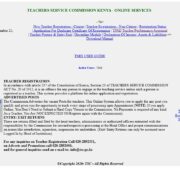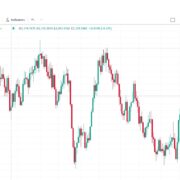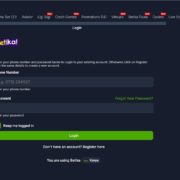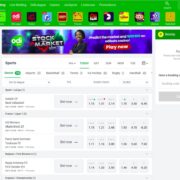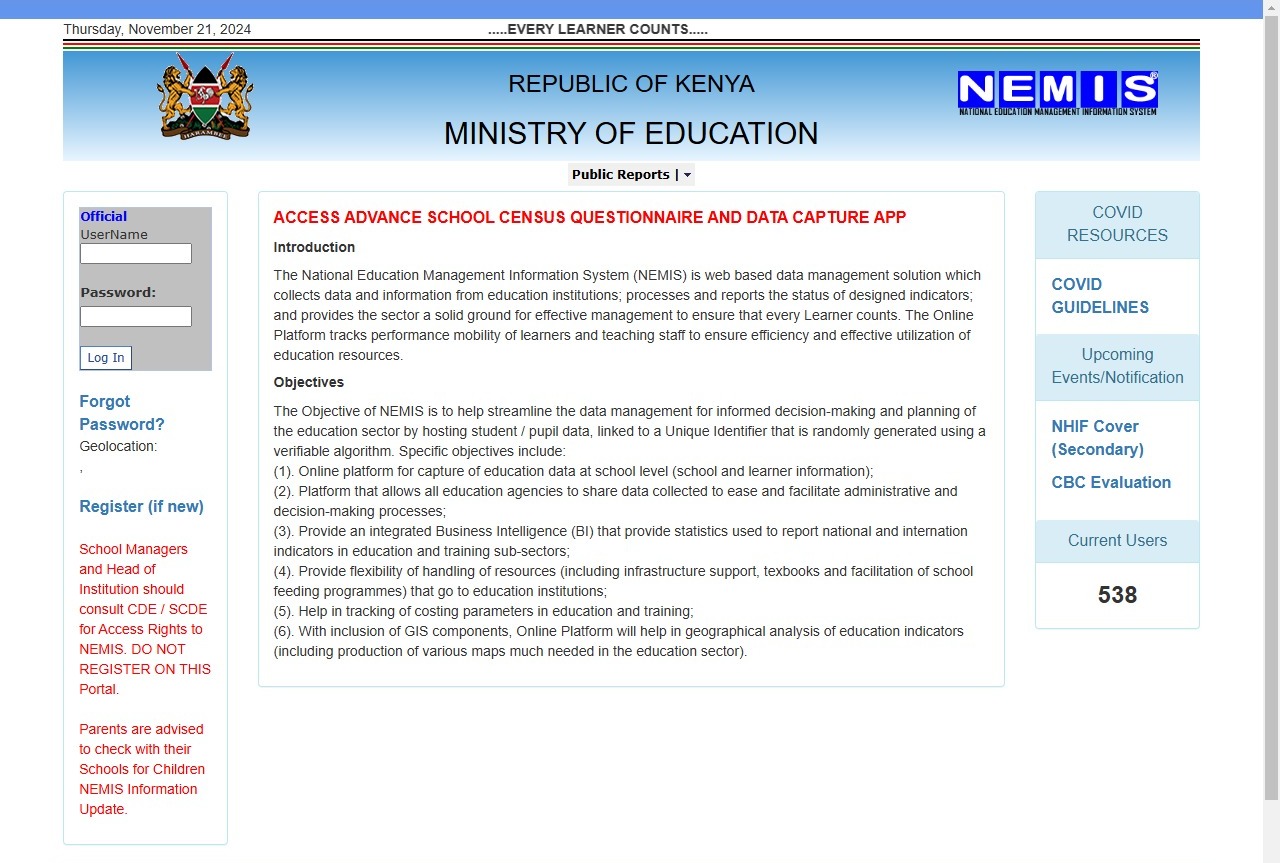
NEMIS Login Guide 2025
Understanding NEMIS Login: A Comprehensive Guide for Users in Kenya
The National Education Management Information System (NEMIS) is a pivotal platform in Kenya’s education sector, designed to enhance the management of educational data. This detailed guide provides an extensive understanding of the NEMIS login process, its significance, and how various stakeholders can utilize it effectively to improve educational outcomes.
What is NEMIS?
NEMIS is an integrated system that serves as a centralized repository for educational data in Kenya. It tracks various aspects of the education sector, including:
- Student Enrollment: Monitoring the number of students enrolled in schools across the country.
- Academic Performance: Collecting data on student performance in various subjects.
- Teacher Information: Maintaining records of qualified teachers and their assignments.
- Resource Allocation: Tracking school resources and needs to ensure equitable distribution.
By centralizing this information, NEMIS plays a crucial role in enhancing the efficiency and effectiveness of educational management. The system allows for better tracking of educational progress and helps identify trends that can inform policy decisions.
Get Money fast with ZangCash Pay in Kenya! Get Money to Pay Bills, Rent, Fees, Shopping and more—Apply now for the support you need via Mpesa
Importance of NEMIS Login
The implementation of NEMIS has brought about significant improvements in the management of educational data in Kenya. Here are some key benefits:
- Improved Decision-Making: Policymakers can access real-time data that informs strategic decisions regarding educational policies, funding, and resource allocation. This leads to more targeted interventions where they are needed most.
- Better Resource Allocation: Schools receive funding and resources based on actual needs rather than estimates, leading to more effective use of public funds. This ensures that resources are directed toward schools with the highest demand.
- Increased Accountability: The system promotes transparency among educators and administrators, ensuring accountability at all levels. Stakeholders can track performance metrics and hold institutions accountable for their results.
- Enhanced Data Security: With a centralized system, sensitive educational data is better protected against unauthorized access. This is crucial for maintaining the integrity of student information.
Who Can Access NEMIS?
NEMIS is designed for multiple user profiles, each with specific functionalities:
- Parents: They can track their children’s academic progress, attendance records, and overall performance. This empowers parents to be more involved in their children’s education.
- Teachers: They manage student information, submit grades, and generate performance reports. Teachers can use this data to tailor their instruction to meet students’ needs.
- School Administrators: They oversee school data management, staff administration, and financial records. Administrators can make informed decisions based on comprehensive data analysis.
- County and Ministry of Education Officials: They monitor performance metrics and make informed decisions based on comprehensive data analysis. This helps ensure that educational policies are effective and responsive to the needs of students.
How to Access NEMIS Login
Accessing the NEMIS portal is straightforward. Follow these steps to log in:
- Open Your Web Browser: Use any web browser on your device (Chrome, Firefox, Safari).
- Visit the Official NEMIS Website: Navigate to NEMIS Portal.
- Choose Your User Profile:
- For parents, click on the “Parent” tab.
- For teachers or school administrators, select the appropriate tab.
- Ministry officials should choose the “Ministry” tab.
- Enter Your Login Credentials:
- Username: This varies by user type. Parents typically receive this from their child’s school, while teachers use their staff ID or designated code.
- Password: Enter your password associated with your account.
Troubleshooting Common Nemis Login Issues
Users may encounter various issues while trying to log into NEMIS. Here are some common problems along with their solutions:
- Forgotten Password: If you forget your password, look for the “Forgot Password” link on the login page. Follow the instructions to reset it via email or SMS verification.
- Incorrect Username: Ensure that you are using the correct username as per your user profile. Double-check any communication from your school or institution for accuracy.
- Technical Issues: If the site is down or unresponsive, try accessing it later or check for updates from the Ministry of Education through their official social media channels or website.
Navigating the NEMIS Dashboard
Once logged in, users will find a user-friendly dashboard tailored to their profile. Here’s what each user can expect:
For Parents
- Student Performance Reports: Access detailed reports on your child’s academic performance across different subjects.
- Example: You can view grades for each subject and see trends over time to identify areas where your child excels or may need additional support.
- Attendance Records: Monitor daily attendance and identify any irregularities that may require attention.
- Example: If your child has missed several days without explanation, you can address this with teachers promptly.
- Communication Tools: Engage with teachers or school administrators directly through messaging features available on the platform.
- Example: Send messages regarding your child’s progress or schedule meetings with teachers directly through the portal.
For Teachers
- Student Management Tools: Update student records efficiently, submit grades promptly, and manage classroom resources effectively.
- Example: Teachers can quickly input grades after assessments and provide feedback directly through NEMIS.
- Reporting Features: Generate reports based on class performance metrics and share them with parents during parent-teacher meetings.
- Example: Create a summary report that highlights class averages and individual student performance for discussions with parents.
- Professional Development Resources: Access training materials and professional development resources provided by the Ministry.
- Example: Participate in online workshops or access teaching resources that help improve instructional methods.
For School Administrators
- Resource Allocation Tools: Manage school resources effectively based on real-time data regarding student enrollment and needs.
- Example: Use enrollment data to request additional funds or materials from the Ministry based on actual student numbers.
- Staff Management Features: Oversee staff performance evaluations and administrative tasks seamlessly through integrated tools.
- Example: Track teacher attendance and performance metrics to ensure accountability among staff members.
- Financial Management Systems: Track school finances and budget allocations effectively to ensure transparency in financial dealings.
- Example: Generate financial reports that show how funds are being utilized within the school for better planning in future budgets.
For Ministry Officials
- Data Analysis Tools: Access comprehensive reports that aid in policy formulation and strategic planning for education initiatives nationwide.
- Example: Analyze trends in student enrollment across different regions to identify areas needing additional support or intervention.
- Performance Monitoring Features: Evaluate school performance metrics across different regions to identify areas needing intervention or support.
- Example: Use performance metrics to allocate resources strategically where they are most needed based on school performance data.
Enhancing Your Experience with NEMIS Login
To maximize your use of the NEMIS platform effectively, consider these tips:
- Regularly Update Information: Ensure that all personal and institutional information is current to avoid discrepancies that could affect funding or resource allocation.
- Tip: Schedule regular checks every term to confirm that all information is accurate and up-to-date.
- Utilize Available Resources: Take advantage of training materials or webinars provided by the Ministry of Education to enhance your understanding of system functionalities.
- Tip: Join online forums where other users share tips and experiences related to using NEMIS effectively based on collective experiences shared by others facing similar situations.
- Engage with Support Services: If you encounter issues or have questions about using NEMIS, reach out to customer support for assistance via email or phone as listed on their website.
- Tip: Keep a record of any issues you encounter along with screenshots if possible; this will help support staff assist you more efficiently.
Frequently Asked Questions about NEMIS Login
To further assist users navigating the NEMIS platform, here are some frequently asked questions:
What Should I Do If I Encounter an Error Message During Login?
If you encounter an error message during login:
- Double-check your username and password for accuracy.
- Ensure that your internet connection is stable.
- If problems persist, contact support for assistance using contact details found on their website.
Can I Change My Password After Logging In?
Yes! Most user profiles allow you to change your password after logging in. Look for a “Change Password” option within your account settings.
Is My Data Secure on NEMIS?
Yes! The NEMIS platform employs robust security measures to protect user data from unauthorized access. Always ensure you log out after using the system, especially on shared devices.
How Often Is Data Updated in NEMIS?
Data within NEMIS is updated regularly—typically at least once per term—ensuring that users have access to current information regarding student enrollments and performance metrics.
Future Developments in NEMIS
As technology continues to evolve, so does NEMIS. The Ministry of Education has plans for future enhancements that may include:
- Mobile Access: Developing a mobile application for easier access to educational data on-the-go.
- Benefit: This would allow parents and teachers to check updates anytime from their smartphones without needing a computer.
- Enhanced Analytics Tools: Introducing advanced analytics features that provide deeper insights into educational trends and outcomes.
- Benefit: Schools could better understand demographic trends affecting enrollment patterns over time.
- Integration with Other Systems: Collaborating with other governmental agencies for seamless data sharing across sectors related to education.
- Benefit: This could streamline processes such as student transfers between schools or sharing health data relevant to students’ well-being.
These developments aim not only to improve user experience but also enhance overall educational management in Kenya by making data more accessible and actionable for all stakeholders involved in education.
Engaging with Community Resources
In addition to utilizing NEMIS effectively, stakeholders should also engage with community resources that complement educational efforts:
- Parent-Teacher Associations (PTAs):
- These associations provide a platform for parents and teachers to collaborate on improving school environments. Regular meetings can foster communication about student needs highlighted through NEMIS data.
- Local Educational Workshops:
- Many communities organize workshops focusing on enhancing students’ skills outside formal education settings (e.g., coding camps). Parents can use insights from NEMIS regarding their children’s strengths when choosing suitable programs.
- Government Initiatives:
- Stay informed about government initiatives aimed at improving education quality (e.g., scholarships for underprivileged students). Information often gets disseminated through schools but can also be found online via government portals linked through NEMIS Login updates.
- Online Forums & Social Media Groups:
- Engage with online communities focused on education where parents share experiences regarding navigating challenges faced within schools—these forums often provide valuable insights into leveraging tools like NEMIS more effectively based on collective experiences shared by others facing similar situations.
- Educational NGOs & Community-Based Organizations (CBOs):
- Many NGOs focus on improving education quality through various programs such as teacher training or providing learning materials. Collaborating with such organizations can enhance local educational initiatives.
- Local Libraries & Learning Centers:
- Libraries often host events aimed at improving literacy rates among children while also providing access to learning materials outside standard curricula—parents should take advantage of these resources available within their communities.
Conclusion
The NEMIS login process is essential for various stakeholders within Kenya’s education system. By understanding how to navigate this platform effectively, users can significantly contribute to improving educational outcomes across the country.
For more information about accessing educational resources in Kenya or details about NEMIS Login functionalities, visit NEMIS Portal today! Engaging with this platform will empower you as a parent, teacher, administrator, or official to play an active role in shaping Kenya’s educational landscape positively.
By staying informed about developments within both technology systems like NEMIS as well as community initiatives supporting education improvement efforts nationwide—together we can foster an environment conducive not just towards academic success but holistic growth among our youth!

